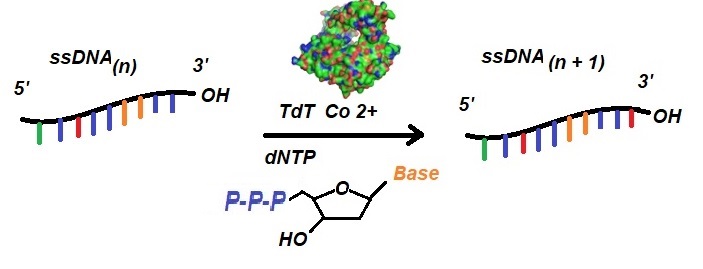The enzyme “terminal deoxynucleotidyl transferase” (TdT) adds several ribonucleotide residues to DNA fragments or primers. TdT can add deoxynucleotidyl triphosphates (dNTPs) randomly to the 3’-hydroxyl group (3’-OH) of single-stranded DNA. TdT catalyzed enzymatic polymerization is an alternative to conventional enzymatic and solid-phase DNA synthesis but allows combination with conventional enzymatic and solid-phase DNA synthesis. This approach is useful for the design and production of novel synthetic polymeric materials used in nanotechnology.
During its natural reaction, TdT adds randomly one to ten nucleotides to DNA but prefers adding dGTP and dCTP. GC regions added to DNA oligonucleotides promote efficient annealing of single-stranded DNA in subsequent ligation reactions. The enzyme also allows the synthesis of sequenced polynucleotides.

Figure 1: Schematic representation of the TdT catalyzed deoxynucleotide addition to ssDNA. Oligonucleotides with free 3’-hydroxyl termini are essential for polymerization initiation by TdT. The enzyme can use either a single-stranded DNA (ssDNA) initiator or double-stranded DNA (dsDNA) with a four-nucleotide 3’-overhang. A TdT-catalyzed enzymatic polymerization reaction needs an initiator oligodeoxynucleotide, natural or unnatural dNTPs, the enzyme TdT, and a buffer supplemented with a metal ion cofactor. The presence of secondary structural motifs at the 3’-ends, such as i-motifs or G-quadruplexes, can hinder access of the catalytic site of TdT, thereby limiting the addition of nucleotides. TdT can incorporate a wide range of natural and unnatural dNTPs, where the preferred order of incorporation is dGTP>dCTP>dTTP>dATP.
Eshaghpour et al., in 1979, reported the specific labeling of DNA fragments with 4-thiouridine at the 3’-ends using a combination of enzymatic and chemical reactions.

Figure 2: Enzymatic addition of 4-thiouridine residues.

Figure 3: α-Haloacetamido derivatives allow modification of the enolic form of 4-thiouridine. A variety of haloacetamides are available for chemical labeling. Chemical moieties such as 5-iodo-acetamidofluroescein (IAF), 5-iodoacetamidoeosin (IOESIN), and azido-bromoacetanilide (ABA) as well as others, can be attached to DNA ends. Many unnatural dNTPs allow adding other functional groups. These groups include biotin, amino-, azide-, alkyne-, dibenzoclyclooctyne-, digoxigenin-, dideoxy dNTPs, fluorescent dyes, as well as photocrosslinking molecules to oligonucleotides.
Bio-Synthesis provides a full spectrum of high quality custom oligo modification services by direct solid-phase chemical synthesis or enzyme-assisted approaches to obtain artificially modified oligonucleotides containing backbone, base, sugar and internucleotide linkages. Bio-Synthesis specialize in complex oligonucleotide modifications using phosphodiester backbone, purine and pyrimidine heterocyclic bases, and sugar modified nucleotides such as our patented 3rd generation Bridged Nucleic Acids.
.png)
Contact us for more info
Reference
Deng G, Wu R. Terminal transferase: use of the tailing of DNA and for in vitro mutagenesis. Methods Enzymol. 1983;100:96-116. [Pubmed]
Deshpande S, Yang Y, Chilkoti A, Zauscher S. Enzymatic synthesis and modification of high molecular weight DNA using terminal deoxynucleotidyl transferase. Methods Enzymol. 2019;627:163-188. [PMC]
Eshaghpour, H., Soell, D., and Cothers, D.M.; (1979) Specific chemical labeling of DNA fragments. Nucleic Acids Res. 7 (6):1485-1495. [PMC]
Flickinger JL, Gebeyehu G, Buchman G, Haces A, & Rashtchian A (1992). Differential incorporation of biotinylated nucleotides by terminal deoxynucleotidyl transferase. Nucleic Acids Research, 20(9), 2382 10.1093/nar/20.9.2382. [PMC]
Gu R, Oweida T, Yingling YG, Chilkoti A, & Zauscher S (2018). Enzymatic synthesis of nucleobase-modified single-stranded DNA offers tunable resistance to nuclease degradation. Biomacromolecules, 19(8), 3525–3535. 10.1021/acs.biomac.8b00816. [PubMed]
Guerra CE (2006). Analysis of oligonucleotide microarrays by 3’ end labeling using fluorescent nucleotides and terminal transferase. Biotechniques, 41(1), 53–56. 10.2144/000112182. [PubMed]
Igloi GL (1998). Strategies for introducing non-radioactive labels during the automated sequence analysis of nucleic acids. Electronic Journal of Biotechnology, 1(1), 23–30. 10.2225/vol1-issue1-fulltext-3. [Link]
Kumar A, Tchen P, Roullet F, & Cohen J (1988). Nonradioactive labeling of synthetic oligonucleotide probes with terminal deoxynucleotidyl transferase. Analytical Biochemistry, 169(2), 376–382. 10.1016/0003-2697(88)90299-0. [PubMed]
Ranajit Roychoudhury, Ernest Jay, and Ray Wu; Terminal labeling and addition of homopolymer tracts to duplex DNA fragments by terminal deoxynucleotidyl transferase. Nucleic Acid Research, 3, 4, 1976, 863-877. [PMC]
Schmitz GG, Walter T, Seibl R, & Kessler C (1991). Nonradioactive labeling of oligonucleotides in vitro with the hapten digoxigenin by tailing with terminal transferase. Analytical Biochemistry, 192(1), 222–231. 10.1016/0003-2697(91)90212-C. [PubMed]
Tauraitė D, Jakubovska J, DabuZinskaite J, Bratchikov M, &Meskys R (2017). Modified nucleotides as substrates of terminal deoxynucleotidyl transferase. Molecules (Basel, Switzerland), 22(4), 672 10.3390/molecules22040672. [PMC]
Tjong V, Yu H, Hucknall A, & Chilkoti A (2013). Direct fluorescence detection of RNA on microarrays by surface-initiated enzymatic polymerization. Analytical Chemistry, 85(1), 426–433. 10.1021/ac303132j. [PubMed]
Winz ML, Linder EC, Andre T, Becker J, &Jaschke A (2015). Nucleotidyl transferase assisted DNA labeling with different click chemistries. Nucleic Acids Research, 43(17). e110.10.1093/nar/gkv544. [PMC]
---...---